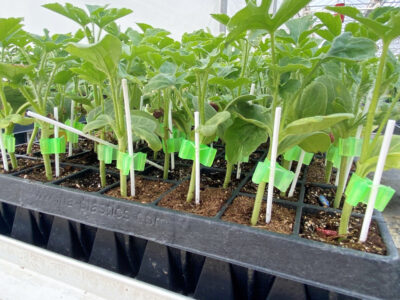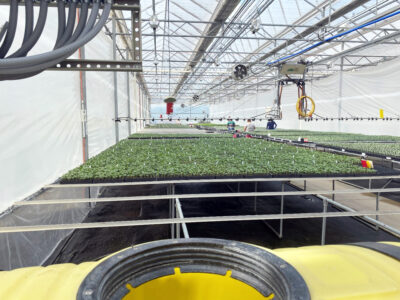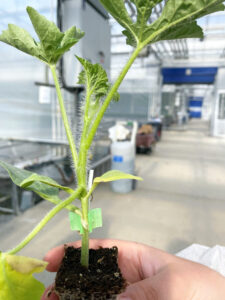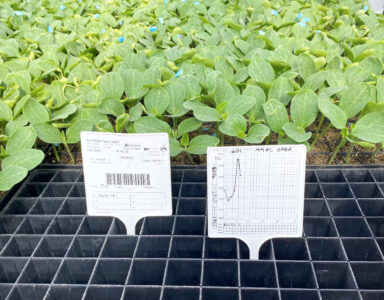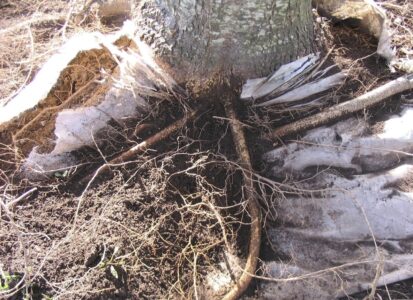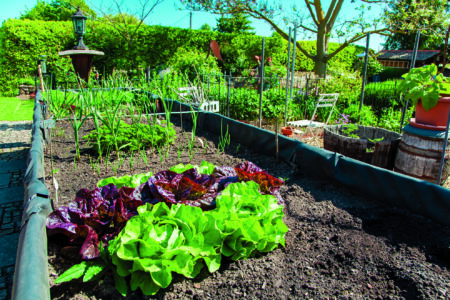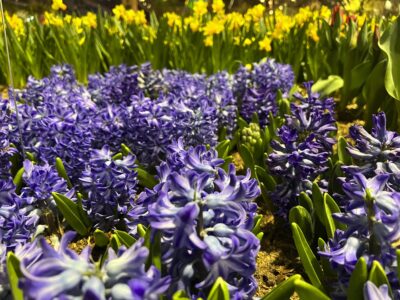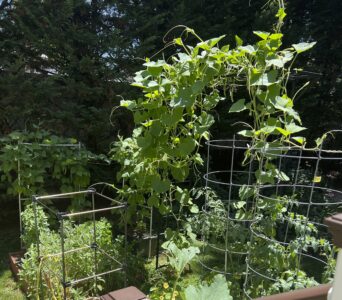Growing grafted plants at Tri-Hishtil Greenhouse, Mills River, N.C.
- PHOTO BY TOM BUTZLER A tray of grafted watermelon transplants ready for shipping.
- PHOTO BY ELSA S’NCHEZ Scion and rootstock seedlings are grown in different sections of the greenhouse.
- PHOTO BY ELSA S’NCHEZ Notice the cotyledon on this grafted watermelon plant’s rootstock (white arrow).
- PHOTO BY ELSA S’NCHEZ The chart in the tray tracks the weight of the flats to determine when to water.
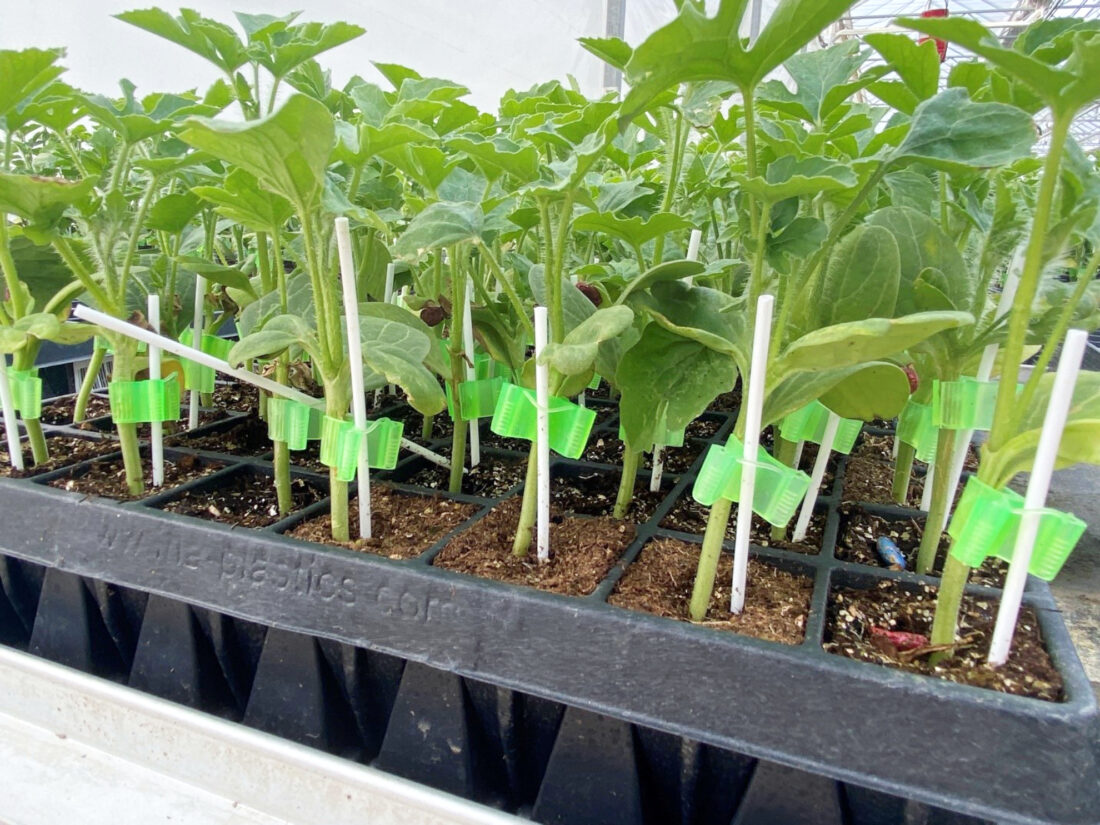
PHOTO BY TOM BUTZLER A tray of grafted watermelon transplants ready for shipping.
Penn State Extension horticulture educators and specialists come into the job with a deep background of knowledge and experience. But like any other field in the workforce, there are advances in horticulture science, marketing, and trends. Staying abreast requires lifelong learning through courses, conferences, and reading scientific and trade journals.
Another way to stay up to date is by participating in professional development horticulture tours. This type of activity gets participants out of their familiar surroundings and view horticulture operations from different perspectives and interact with horticulturists and plant enthusiasts with a wide range of opinions.
A planning committee of Penn State Extension Educators created a tour centered around horticulture in western North Carolina. The area is rich in ornamental, fruit, and vegetable production. Twenty-one educators and specialists participated during the last week of June 2022. The series of articles that follow will give an overview of our Professional Development Tour.
One stop on our tour was to Tri-Hishtil Greenhouse, an operation where about 90,000 plants are grafted each day by hand for vegetable farmers up and down the eastern U.S. Bert Lemkes, the general manager, took us through the grafting process.
Grafted plants cost more than plants on their own rootstock. In fact, Bert explained that they could cost 3 to 3.5 times the amount of non-grafted plants. For many farmers, this increased cost is worth it because grafted plants provide an alternative to fumigation used to address diseases caused by soilborne pathogens. Using grafted plants is also a way to mitigate the effects of plant stress caused by cold, heat, salinity, and more. Researchers have also shown that fruit quality is improved depending on the situation. We saw this in our study where we evaluated muskmelon (cantaloupe) cultivars. We found that fruit from the combination of “Aphrodite” scion and “RS841” rootstock may have a better flavor than “Aphrodite” alone.
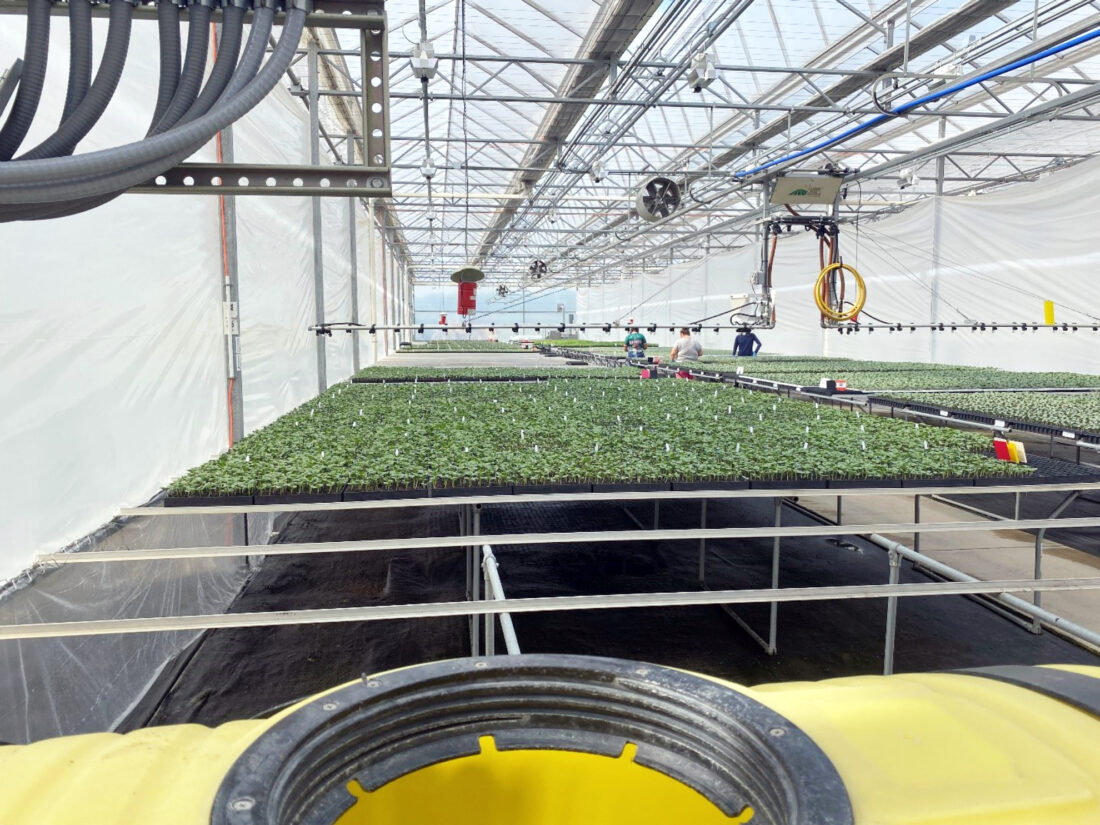
PHOTO BY ELSA S’NCHEZ Scion and rootstock seedlings are grown in different sections of the greenhouse.
In addition to muskmelon, U.S. farmers are increasingly growing grafted tomato, eggplant, pepper, cucumber, and watermelon. Ninety percent of the grafted plants produced by Tri-Hishtil are watermelon. Of those, 75% are triploid or seedless, and 25% are diploid or seeded.
Watermelon grafting uses rootstocks primarily with resistance to the fungus Fusarium oxysporum f. sp. niveum that causes fusarium wilt. This fungus is host-specific, meaning it is only a problem on watermelon and will not disease any other plants. Infected plants first are stunted and wilt in the heat of the day. This wilting appears to lessen by the evening. With time, plants completely collapse and die. Fusarium oxysporum f. sp. niveum is soilborne and can survive for up to 10 years in the soil, making it very difficult to manage.
An interspecific squash hybrid and the watermelon cultivar Carolina Strongback have some resistance against F. oxysporum f. sp. niveum and therefore to fusarium wilt. The interspecific squash hybrid has a high degree of resistance; however, it is susceptible to root knot nematodes. On the other hand,
“Carolina Strongback” has intermediate resistance to F. oxysporum f. sp. niveum but high resistance to root knot nematodes. Farmers select which rootstock to use depending on the issues they face.
Additionally, both rootstocks impart plants with additional vigor. Practically, plant populations can be reduced by half or 2/3 which can help offset the high cost of grafted plants.
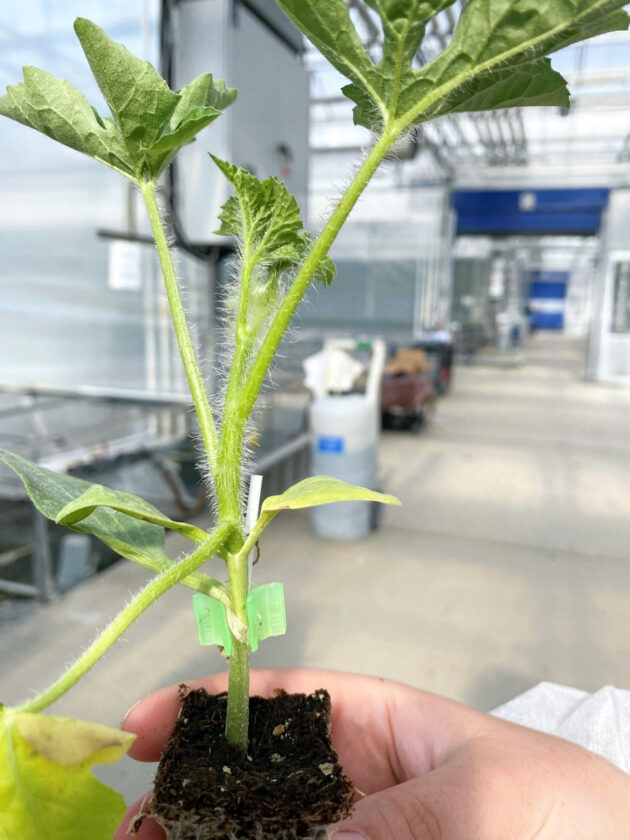
PHOTO BY ELSA S’NCHEZ Notice the cotyledon on this grafted watermelon plant’s rootstock (white arrow).
A challenge to using these rootstocks is that the first harvest is delayed. The more vigorous rootstocks require a different irrigation regime and fertigation schedule than other plants. Bert used the analogy of the more vigorous rootstock being a turbo engine compared to a standard engine or rootstock on non-grafted plants. Tri-Hishtil is working on adjusting irrigation regimes, fertigation rates, and scheduling to match the needs of grafted plants to overcome this challenge. Bert also mentioned delaying applying early fertilizer with these rootstocks, which can be an advantage, especially considering the current fertilizer prices.
Tri-Hishtil grows to order, and customers decide on the scion and which rootstock meets their needs. Once that is decided, the process then proceeds in a greenhouse headhouse by preparing trays for seeding. Uniformity is critical. Trays, media, and other supplies are kept in an area with temperatures maintained at 68∂ F year-round.
Watermelon seeds cost about 25 cents each. For reference, conventional field tomato seeds cost about 6-10 cents each. The higher watermelon seed cost means they must be handled carefully. Planting about 40% more seeds than are required ensures that enough transplants are ready for customers.
After planting seeds, team members apply warm water to the trays to raise the temperature to within the optimal range for germination. Additionally, they weigh the tray after watering. From this point on, adding additional water is based on the weight of the tray, which is tracked on a chart. Next, the trays go into a germination room.
Rootstock plants are started about 9 days after the scion plants to account for their higher level of vigor. Staggering planting between the rootstock and scion results in both sets of plants reaching the optimal stage for grafting at the same time.
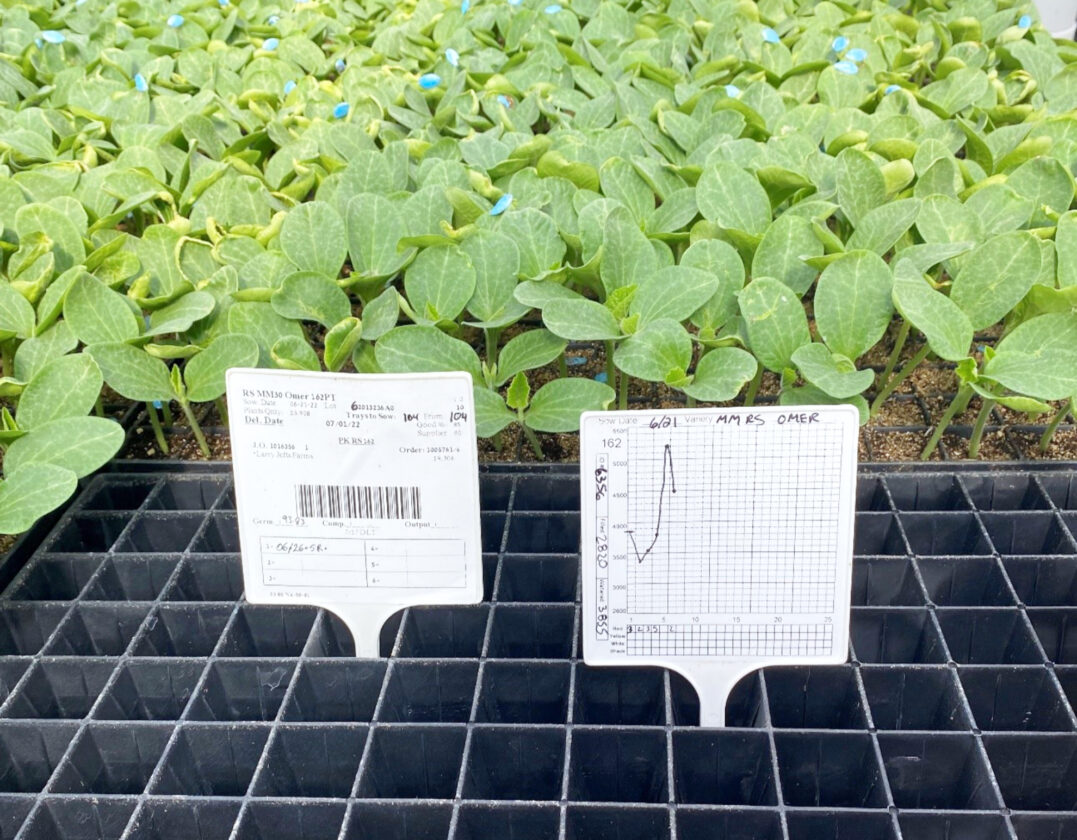
PHOTO BY ELSA S’NCHEZ The chart in the tray tracks the weight of the flats to determine when to water.
Once plants have germinated, scions and rootstocks are placed in different greenhouse sections with year-round supplemental lighting to minimize variable levels of natural light affecting plant growth and development. Seedlings are then moved to a grafting room when they reach the optimal stage.
Tri-Hishtil employs about 80 people who graft by hand. Each grafter takes the scion and rootstock through the entire process. A reasonable grafting rate is about 160-170 plants per hour, and Bert said the grafting success rate is between 93 and 94%.
Watermelon grafting is challenging to automate because precision is needed, which is difficult to achieve with a machine. Grafters remove the plant canopy, leaving one of the two cotyledons on the rootstock. Each cotyledon has a bud at its base. Grafters remove the canopy leaving one cotyledon but removing its bud. When grafting tomatoes, grafters remove both cotyledons from the rootstock. This simplifies the process and opens it up to the possibility of automation.
Additionally, during grafting, grafters remove the roots on the interspecific squash hybrid or “Carolina Strongback” watermelon to account for the higher vigor that the rootstock has compared to the scion. After a week of healing, the root system redevelops.
After grafting, plants are placed in a healing chamber with carefully controlled light, relative humidity, and temperature levels, and a 16-hour photoperiod for 7-8 days. Plants are hardened off and shipped after healing. The entire process takes about 6 weeks. You can see this process in a video on Tri-Histil’s website, (trihishtil.com).

